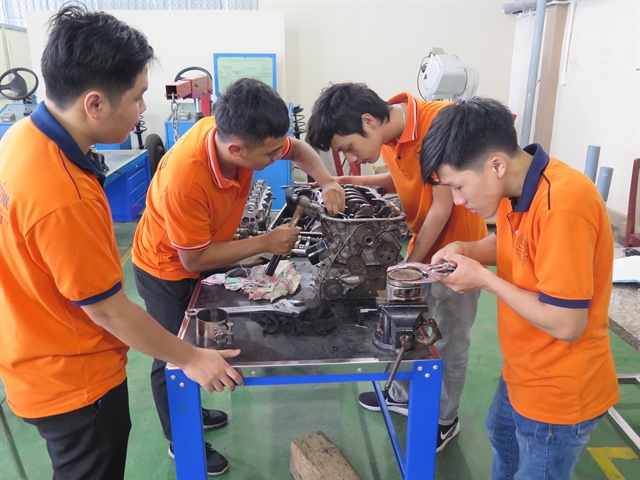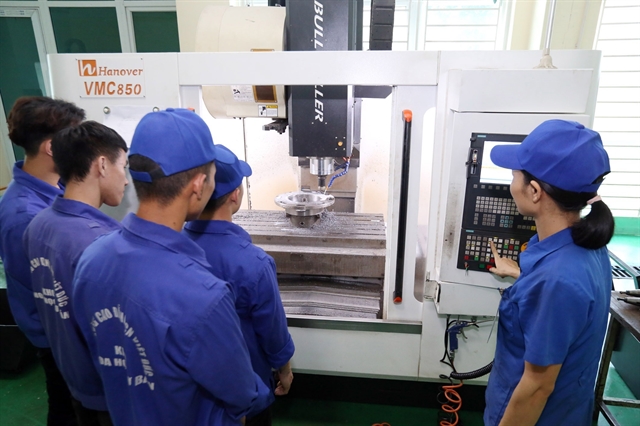 Society
Society


|
| Students practise automotive engine assembly and disassembly at Lạc Hồng University in southern Đồng Nai Province. — VNA/VNS Photo Minh Hưng |
HÀ NỘI — Việt Nam needs to accelerate the development of a skilled labour force, especially individuals with advanced skills, in order to meet the demands of the labour market, enhance labour productivity and increase national competitiveness, experts have said.
On the occasion of Việt Nam's Labour Skills Day (October 4), Nguyễn Bích Lâm, former general director of the General Statistics Office, highlighted the pivotal role of labour skills in determining the productivity and effectiveness of employees in Việt Nam.
Figures from the General Statistics Office showed that the labour productivity in Việt Nam experienced an annual increase of 4.65 per cent on average during the years of 2021 and 2022. However, this growth rate fell short of the targets outlined in the socio-economic development plan for the 2021-25 period and the 10-year socio-economic development strategy for the 2021-30 period. These plans set a target of achieving an average annual labour productivity growth rate of over 6.5 per cent.
That meant to reach the goals for the 2021-25 period, Việt Nam must strive for an annual labour productivity increase of around 7.8 per cent in the next three years.
"This presents a significant challenge for Việt Nam's economy. The practical development of the country has shown that accelerating labour productivity growth is crucial for the competitiveness of the economy," he said.
Lâm also pointed out that there were issues with the current training structure, a shortage of highly skilled workers, and a significant gap between vocational education and the labour market's demands.
Some workers lacked training in discipline and some workers lacked teamwork skills, cooperation and risk-taking abilities, and were hesitant to innovate.
These were barriers to improving labour productivity, he said.

|
| Students engage in vocational training at the High-Tech Training Centre of Việt Nam-Germany Industrial College. — VNA/VNS Photo |
A representative of the Ministry of Labour, Invalids and Social Affairs’ General Department of Vocational Education noted that Việt Nam had a relatively abundant labour force compared to many countries in the region and the world.
However, there were still imbalances in the labour force structure by education level and economic sectors. Only 26.4 per cent of the labour force had vocational certificates.
The labour market still saw an imbalance in labour supply and demand between regions, areas, and economic sectors. Informal labour and unskilled labour still dominated, making this sector the weakest in terms of occupational skills.
Commenting on the labour market's demand in the Mekong Delta, a region with unique importance, potential, and advantages in key economic sectors, Vice President of the HCM City’s Vocational Education Association Trần Anh Tuấn said the labour market in Việt Nam, especially in the key economic region in the South and the Mekong Delta, has shown continuous growth.
Tuấn said the technical expertise of labourers through training has increased rapidly in terms of quantity, but it was not met with the labour market's demand, especially the demand for high-quality labour.
He forecast that in the future, the labour structure would shift from simple occupations to specialised technical jobs, making manual labour less competitive.
Đặng Thị Hồng Diệp of the Trade Union University suggested that functional agencies develop and provide training programmes to enhance vocational skills for fresh graduates before they enter the workforce and programmes to improve skills for workers during their employment. These programmes should be tailored to the specific needs of different employer groups.
Encouraging employers to participate in skill training and organising short-term skill training courses for their employees was also important, she added.
Nguyễn Thị Lê Uyên from the HCM City’s Institute for Research and Development said retraining and upskilling for employees would include two directions.
Firstly, training and retraining employees within the same field or industry, but with a focus on embracing new technologies. For instance, transitioning from traditional agriculture to high-tech agriculture, or from manual textile and garment manufacturing to industrial, high-tech, and automated processes.
Secondly, retraining employees to switch careers due to the obsolescence of old professions. For example, moving from agriculture to industry or services, or from industry to control and automation, she said. — VNS




